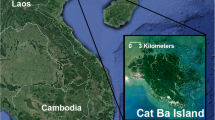Abstract
Little published information exists detailing home range changes among nonhuman primates. Resulting from human destruction of the habitat, one of the observed Nilgiri langur troops was forced to relocate its home range, during which several interesting behavioral patterns emerged. Most important was the observation that the animals were very reluctant to desert the home range, even when the last trees in the core area were being destroyed. Adult males and adult females responded differently to the destruction and resultant shift. The males appeared less nervous than the females and deserted the home range prior to them. The reaction of surrounding troops to the shift of troop A, strongly suggests territorial behavior among Nilgiri langurs. Finally, this shift, along with other observations reported elsewhere, demonstrates that Nilgiri langurs are quite adaptable and appear to possess the ability to survive in an ecology being rapidly destroyed by the human population.
Similar content being viewed by others
Bibliography
Anonymous, 1953. A local variety of Nilgiri langur.J. Bom. Nat. Hist. Soc., 51(3): 25–28.
Bernstein, I., in press. The lutong of Kuala Selangor.
Bourlière, F., 1962.Natural History of Mammals. Alfred A. Knopf and Sons, New York.
Burt, W. H., 1943. Territoriality and home range concepts as applied to mammals.J. Mam., 24: 346–352.
Calhoun, J. B., 1963. Social use of space.Physiological Mammology, 1: 1–187.
Carpenter, C. R., 1964.Naturalistic Behavior of Nonhuman Primates. The Pennsylvania State University Press, University Park.
Davis, D. E., J. T. Emlen, &A. W. Stokes, 1948. Studies on home range in the brown rat.J. Mam., 29: 207–225.
DeVore, I., 1963. A comparison of the ecology and behavior of monkeys and apes. In:Classification and Human Evolution,S. L. Washburn (ed.) pp. 301–316.
Furuya, Y., 1961–62. The social life of silvered leaf monkeys,Trachypithecus cristatus.Primates, 3(2): 41–60.
Grigg, B., 1880.A Manual of the Nilgiri District. Government Press, Madras.
Hall, K. R. L., 1960. Social vigilance behavior of the chacma baboon.Behavior, 16: 261–294.
——, 1965. Behavior and ecology of the wild patas monkeys,Erythrocebus patas, in Uganda.J. Zool., 148: 15–87.
Jay, P. 1965. The common langur of north India. In:Primate Behavior: Field Studies of Monkeys and Apes,I. DeVore (ed.) pp. 197–250.
Kaufmann, J. H., 1962.Ecology and Social Behavior of the Coati, Nasua narica on Barro Colorado Island, Panama. University of California Press, Berkeley.
Leigh, C., 1926a. Weights and measurements of the Nilgiri langur (Presbytis johnii).J. Bom. Nat. Hist. Soc., 30(1): 223.
——, 1926b. Breeding seasons of the Nilgiri langur,J. Bom. Nat. Hist. Soc., 30(3): 691.
Lindsay, H. M., 1926. Bombay natural history society mammal survey of India, Burma, and Ceylon, Report 43.J. Bom. Nat. Hist. Soc., 30(3–4): 591–656.
McCann, C., 1933. Observations on some of the Indian langurs.J. Bom. Nat. Hist. Soc., 36(3): 618–628.
Osman Hill, W. C., 1934. A monograph on the purple-faced leaf-monkeys (Pithecus vetulus).Ceylon J. Sci., (b) Vol XIX Pr. I, 23–89.
Pocock, R. I., 1928. The langurs or leaf-monkeys of British India.J. Bom. Nat. Hist. Soc., 32(1–2): 472–505; 660–678.
Poirier, F. E., 1968a.The Ecology and Social Behavior of the Nilgiri Langur (Presbytis johnii) of South India. University microfilms, Ann Arbor.
--, 1968b. Nilgiri langur (Presbytis johnii) territorial behavior. Paper to be presented to 2nd International Congress of Primatology, Atlanta.
Prater, S. H., 1965.The Book of Indian Mammals. Diocesan Press, Madras.
Ripley, S., 1967. Intertroop encounters among Ceylon gray langurs (Presbytis entellus). In:Social Communication among Primates,S. A. Altmann (ed.) pp. 237–253.
Ryley, K. V., 1913. The Bombay natural history society mammal survey of India. Report 10 (Kathiawar) and report 11 (Coorg).J. Bom. Nat. Hist. Soc., 22(3): 13–76.
Sterndale, R. A., 1884.Natural History of the Mammals of India and Ceylon. Thacker, Spink and Company, Calcutta.
Sugiyama, Y., 1965a. Home range, mating season, male group and intertroop relations in Hanuman langurs (Presbytis entellus).Primates, 6(1): 73–106.
——, 1965b. On the social change of Hanuman langurs (Presbytis entellus) in their natural condition.Primates, 6(3–4): 381–418.
--, 1967. Social organization of Hanuman langurs, In:Social Communication among Primates,S. A. Altmann (ed.) pp. 221–236.
Tanaka, J., 1965. Social structure of Nilgiri langurs.Primates, 6(1): 107–122.
Washburn, S. L. & D. Hamburg, 1965. The implications of primate research. In:Primate Behavior: Field Studies of Monkeys and Apes,I. DeVore (ed.) pp. 607–622.
Author information
Authors and Affiliations
Additional information
This study was supported by Public Health Service grant MH 11099-01 attached to Fellowship 2 F1-MH-22, 140-02 (BEH).
About this article
Cite this article
Poirier, F.E. Analysis of a Nilgiri langur (Presbytis johnii) home range change. Primates 9, 29–43 (1968). https://doi.org/10.1007/BF01795884
Received:
Issue Date:
DOI: https://doi.org/10.1007/BF01795884




